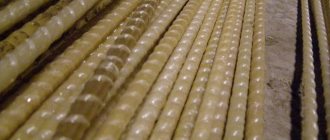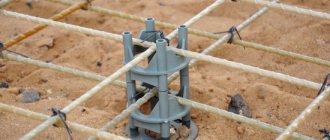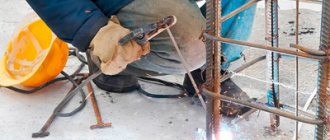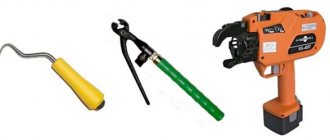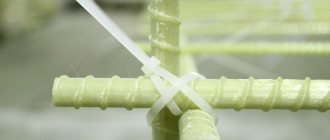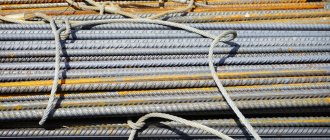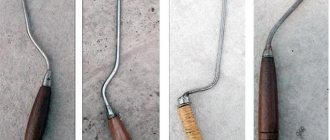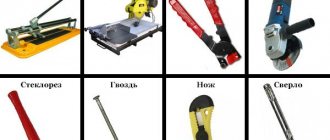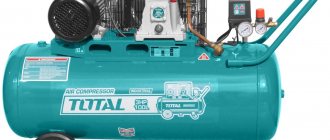Basic cutting options
Working with a hacksaw on metal
When preparing material on how to cut reinforcement, it was necessary to analyze many recommendations published on the pages of Internet forums on this topic. The results of the study were ultimately reduced to the following main cutting options:
- working with a regular hand hacksaw;
- cutting using hand-held metal shears (with hydraulics), so-called “bolt cutters”, which can be used for reinforcement diameters of no more than 6-8 mm;
- using a cutting torch;
- cutting reinforcement using a grinder (angle grinder) with discs for concrete.
Hand hacksaw
Some forum visitors even suggest using powerful hydraulic shears, which are equipped with rescue services.
Cutting composite reinforcement with an angle grinder (“grinder”)
Like everything in the world, this method has its pros and cons.
Advantages of cutting composite reinforcement with a grinder
- cutting speed of the bar - you will make it quickly enough (the fastest of the proposed methods); — the ability to cut several rods at once; - low labor costs; — it is possible to use any disc (for metal, for stone, diamond, grinding).
Disadvantages of cutting composite reinforcement with a grinder
— when cutting reinforcement with an angle grinder, the cut is made by a disk rotating at high speed. Therefore, when cutting, a stream of fiberglass dust flies from under the disk, which then hangs in the air for a long time. The cooling system of a power tool (blowing) only increases this moment. Therefore, cutting with a grinder must be done using protective equipment, such as goggles, gloves, and a respirator. It is better to carry out work outside; — working with a grinder, like any other type of power tool, is possible only if there is a working electrical outlet in the area where the work is being done.
MECHANICAL PROCESSING OF GLASS TEXTOLITES, TEXTOLITES, GETINAKS
Laminates
can be subjected to all types of mechanical processing that are used for the manufacture of metal parts. However, if the production of parts from laminated plastics is not reduced to the production of separate one-time batches, when the wear of the cutting tool can be neglected, then the cutting modes and geometry of the cutting tool differ from those used for the manufacture of metal parts.
Unlike metals, laminated plastics have lower thermal conductivity (200 times less than iron and copper). In this case, the use of coolants or water is unacceptable, since they can lead to a deterioration in the physical-mechanical and especially electrical properties of laminated plastics. The use of air to cool cutting tools and parts is not effective enough.
More efficient means of heat dissipation
and, when the contact area of the cutting tool with the surface of the plastic decreases, it is to use a tool in which the main and auxiliary rear angles are maximized. At the same time, the lower mechanical strength and hardness of laminated plastics require less cutting force (6-20 times less than that of metals). This allows you to make the cutting part of the tool more pointed without fear of losing its strength.
However, under all these conditions, it should be taken into account that under incorrect cutting conditions, burning of plastics from the surface may occur or, due to overheating, destruction processes may occur even inside the parts, leading to deterioration in the physical, mechanical and electrical properties of the material of the parts.
.
Despite the lower need for cutting forces, laminates have a fairly large influence on the wear of the cutting tool. This especially applies to fiberglass laminates
, when the abrasive properties of the material lead to rapid wear of the cutting tool and it is even necessary to resort to the use of diamond tools.
Some reduction in cutting tool wear can be achieved by intensive removal of chips and dust, which can contribute to premature wear. Such removal is also necessary to avoid the accumulation of dust generated during the processing of laminated plastics in the room. Therefore, the equipment used for processing must be equipped with a reliable suction device.
Differences in fittings
In addition to length, metal rods can differ from each other in their diameter and class (from A-1 to A-7).
The higher the class of reinforcement, the more durable it is considered.
The easiest way to visually identify class A-1 reinforcement is that it has a smooth surface. The remaining classes (from A-2 to A-7) are periodic profile rods. All fittings of the above classes are hot-rolled.
If the metal rods have been hardened by thermomechanical treatment, the letter “t” will appear in their designation: from At-3 to At-7.
Rebar cutting tool
The best way to cut reinforcement depends on its diameter and class. The smaller they are, the easier it is to handle the metal rod.
Therefore, for cutting A-1 reinforcement (with a diameter of up to 10-12 mm), ordinary bolt cutters are also suitable (they are also called rebar shears or rebar cutters). With their help, you can handle a small number of rods quite easily, since the force you apply is increased due to the double lever system working in them.
We recommend reading: Do-it-yourself reinforcement of a columnar foundation, calculation and diagram
For cutting thicker and more durable reinforcement, a grinder is more suitable. Its main advantages (light weight and power) allow you to work quickly, and since you can use it to cut reinforcement wherever there is space and there are no flammable materials nearby, it is what craftsmen usually give preference to.
Another option is a special guillotine for reinforcement (for example, EDMA RODCUT 0659). This device greatly facilitates the process of cutting reinforcement into pieces of a certain length. True, a guillotine is quite expensive, so it is usually purchased by specialized companies, and not by those who like to build something with their own hands.
You can also use a special machine for cutting reinforcement, which greatly facilitates and simplifies the entire process.
Advantages and disadvantages
Fiberglass reinforcement is an excellent option for strengthening the foundation. This material increases its strength, increases service life and allows it to withstand high loads.
If you are thinking which reinforcement is better - fiberglass or metal, it is worth considering the important positive features of composite reinforcement over steel:
- a light weight. Compared to metal products, composite reinforcement is 9 times lighter. For this reason, you do not need to use special expensive equipment to install it;
- fiberglass elements are highly resistant to chlorine and other acidic, aggressive substances. Compared to steel products, the stability coefficient of composite products is 10 times higher;
- low level of thermal conductivity. Due to the fact that the reinforcement heats up and cools down, it does not cause destruction of the internal part of concrete structures;
- Composite products have the properties of dielectric non-conductivity and electromagnetic permeability. This means that they cannot conduct electricity and do not interfere with radio waves;
- have tensile strength. Compared to metal, it is 2-3 times higher;
- increased resistance to corrosion;
- easy transportation;
- low price. Compared to metal products, fiberglass rods are much cheaper.
Do not forget about the disadvantages of composite products:
Fiberglass reinforcement has a low modulus of elasticity and can be easily bent. During the construction of the foundation and paths, this drawback is not noticeable
But if the products are used in the construction of floors, then this nuance should not be missed; it is important to carry out all the necessary calculations; The products have an insufficient level of heat resistance. You should not combine fiberglass reinforcement with concrete mortar under strong temperature changes, otherwise it may completely lose its binding properties; fragility
Over time, composite products wear out and begin to deteriorate; exposure to an alkaline environment also has a huge impact on rapid wear. But manufacturers, in order to increase the service life of fiberglass reinforcement, began to add rare earth metals to its composition; not intended for welding.
How to cut rebar correctly and safely
If you decide to cut reinforcement with a grinder, do not forget to take care of your safety:
- firstly, remember about special glasses, comfortable work gloves and appropriate clothing;
- secondly, the reinforcement that you are going to cut must be raised above the surface (above the ground) so that the grinder disk does not catch on it;
- thirdly, the reinforcement to be cut must be secured (or simply held so that it does not move while you cut it - for this you will need an assistant).
Cutting upon purchase
If you buy reinforcement in a store or warehouse in small quantities, ask workers to cut it into pieces of the length you need right there. Typically, many sellers provide this service (for a fee or free of charge), trying to attract as many buyers as possible, since cutting reinforcement in this “method” is much more profitable:
- you don’t have to look for a car and transport long reinforcement bars;
- the reinforcement will arrive at your construction site already cut into pieces of the required length, and you can immediately start working with it;
- you do not need to cut the reinforcement yourself and look for the necessary tools for this.
Just remember to calculate in advance the number and length of reinforcing bars you need.
How to cut composite reinforcement
One of the main advantages of composite reinforcement is the simplicity of its cutting. Cutting of fiberglass reinforcement is carried out directly at the work site, which significantly reduces construction time. To cut rods to size, use the following tools:
- axe;
- bolt cutter;
- hacksaw for metal;
- angle grinder.
Let's look at the advantages and disadvantages of each tool.
Angle grinder
When the question arises of how to cut fiberglass reinforcement for the foundation (we have already written in more detail about the material itself here), builders first of all remember the grinder. This tool allows you to cut a large amount of material efficiently, quickly and with minimal effort.
The advantages of using an angle grinder include:
- high speed;
- using a grinder you can cut a bunch of rods at once;
- mechanized cutting does not require much muscle strength;
- possibility of using discs with any cutting edge (for metal or stone).
We recommend reading: Collection of foundation loads, how to calculate, examples
Before cutting fiberglass reinforcement with a grinder, you need to take into account the disadvantages of working with this tool:
- It will not be possible to cut fiberglass with a grinder without dust. The high speed of rotation of the disk leads to the spraying of small particles of fiberglass into the air. Using an air blower to cool the tool's motor further spreads the composite dust. Therefore, when working with an angle grinder, you need to use eye and respiratory protection, especially if you are cutting reinforcement indoors;
- To operate an angle grinder, you must have an electrical connection point.
In general, the disadvantages are quite trivial.
Hacksaw for metal
If you only need to make a few cuts, you can use a regular hacksaw.
The use of hand tools provides the following advantages :
- Every owner has a hacksaw for metal. This is the easiest and cheapest way to cut a small number of rods for a bundle of reinforcement cage;
- no spraying of small particles, as is the case with an angle grinder.
Disadvantages of using a hacksaw for cutting composite reinforcement:
- low speed;
- high load on the employee if it is necessary to perform a large amount of work;
- Possibility of use only in individual construction with small volumes of work.
Bolt cutter
Before cutting composite rebar with a bolt cutter, you should also learn the pros and cons of working with this tool. You need to understand that the bolt cutter does not cut the composite rod, but rather cuts it, which affects the technical characteristics of the material.
Benefits of using a bolt cutter:
- no electrical connection required;
- When working with a bolt cutter, a large number of small particles are not formed, so rods can be prepared to size indoors;
- With a bolt cutter in your hands, you can move and work anywhere (no wires).
Disadvantages of using a bolt cutter:
- using a bolt cutter, you cannot cut more than 3 rods at the same time;
- when working with this tool, it is necessary to use significant muscle effort;
- A bolt cutter is rarely on the list of household tools. To operate, you will have to rent or buy it, which is not economically feasible;
- the use of a bolt cutter causes deformation of the material at the cut site (crumbs of material and longitudinal cracks appear at the end of the rod). Such deformation reduces the load-bearing capacity of the reinforcement and shortens its service life.
Axe
If funds are limited, an ax can also be used to prepare the reinforcement. It, like a bolt cutter, cuts the rod, which affects the condition of the reinforcement at the point of cutting.
Positive points:
- Every owner has an axe. There is no need to purchase the tool separately;
- speed. When preparing the base for cutting reinforcement, the work can be completed quite quickly.
Negative points:
- inaccuracy of the cut. Not every master can accurately and strongly hit the right place with an ax to cut a composite rod;
- deformation of the tip of the rod. During operation, water, cement, and alkali can get into longitudinal cracks, which will lead to a violation of the technical characteristics of fiberglass and weakening of the entire structure. With temperature changes, the split reinforcement inside the product will change in volume, which will lead to the destruction of concrete.
Technology of foundation reinforcement with composite materials
The low weight of plastic reinforcement for the foundation simplifies the process of assembling a reinforcement frame of any design. At the same time, due to the increased strength of the material, the cross-sectional diameter is taken one number less than for metal analogues.
The technological process of installing concrete monolithic structures using polymer rods consists of the following stages:
- installation of formwork and marking the level of pouring concrete mixture;
- assembly and installation of the reinforcing frame;
- pouring concrete into formwork;
- removal of formwork panels.
Work on the installation of reinforced monolithic structures must be carried out in accordance with the adopted design decisions. The deck configuration must fully correspond to the size and shape of the foundation. As formwork material, you can use standard factory-made panels, boards, moisture-resistant plywood or chipboard. For permanent formwork, expanded polystyrene sheets are most often used.
After assembling and securing the formwork panels, on their inside, using a water level, mark the upper limit of pouring the concrete mixture. This will reduce the time it takes to complete the job and help distribute the concrete more evenly.
Spatial reinforcing frame for strip foundation
The foundation reinforcement scheme, laying and rod diameter are always indicated in the project. The use of composite reinforcement, especially those based on carbon fiber, makes it possible to reduce the diameter of the rods by one size. The laying of the material must exactly correspond to the calculated data. The frame is assembled on a level area.
The work begins with cutting the workpieces. To do this, pieces of the required length are unwound from the coil and placed on stands at a height of 35-50 mm above the support pad or ground. After this, the transverse jumpers are laid according to the drawing, and at the intersections they are tied with wire or ties. In this way, the bottom row of the spatial reinforcement frame will be assembled.
At the next stage, it is necessary to assemble a lattice completely similar to the first one, lay it on top and then cut the vertical posts to the designed length. The first post is tied at the corner of the flat gratings, the second at the adjacent intersection, as a result, a spatial structure is gradually formed. If there are more horizontal rows, then the second grid is fixed at the required height, and then the next one is fixed. The vertical post in this case is one whole segment.
Plastic fasteners.
It is necessary to pour a sand-crushed stone cushion at the bottom of the trench and compact it well. After this, it is recommended to cover the sand layer with geotextile or waterproofing material. This will prevent moisture from entering the concrete and the germination of weeds.
Horizontal reinforcement of slab foundations
When pouring slab-type foundations, horizontal reinforcement technology is used. Its main feature is the absence of turning and adjacent sections. Usually these are two grids located one above the other from long straight rods and vertical posts.
All work is carried out on site. First, according to the design drawing, the lower mesh is knitted, and the upper mesh is laid on top of it. After this, vertical posts are installed, as described for strip structures. The lower mesh must be installed on stands.
Pouring concrete onto a plastic reinforcement frame
Technologically, pouring a concrete mixture is no different from work using steel reinforcement
However, given the lower strength of the material under lateral radial impact, compaction with a vibrator should be done carefully so as not to damage the integrity of the plastic rods
It is not recommended to use a manual tamper, because... concrete pressure can change the configuration of the reinforcing structure.
Recommendations for cutting composite reinforcement
Before cutting plastic reinforcement with your own hands, you should familiarize yourself with the safety precautions when performing work.
We recommend reading: Calculation of a pile foundation: load-bearing characteristics, loads, grillage, cost calculation
When working with electromechanical tools, the following protective equipment must be used:
- respirator. Small composite particles spread quickly in the air, especially if work is carried out indoors. To protect the respiratory system, it is necessary to wear a respirator and carefully adjust it to the size of the face;
- protective glasses. When cutting fiberglass with an angle grinder, small particles often fly off. Getting such particles into the eyes is fraught with damage to the integrity of the cornea and inflammatory processes. Therefore, protect the eyes with a mask or special glasses;
- gloves with a latex layer will protect the skin of your hands from small particles of fiberglass.
Cutting composite reinforcement with a hacksaw
Advantages of cutting fiberglass reinforcement with a hacksaw
- the tool is cheap and available in almost every household.
Advantages of cutting fiberglass reinforcement with a hacksaw
- slow cutting; - high labor costs; — it is advisable to use for small volumes of work.
We consider the optimal combination to be the presence and use of an angle grinder and a bolt cutter. Use a grinder to cut the bulk of the volume, and use a bolt cutter to trim the tails. (Of course, if there is electricity at the site).
Leading manufacturers
There are about 10 proven manufacturers of fiberglass reinforcement that have managed to prove themselves in this market segment. Moreover, enterprises exist in almost all major geographical areas: the central part of Russia, as well as Siberia and the Urals. Let's name the largest of them:
- NPC "Spetspolymer", NPC "ARMASTEK", Moscow Composite Materials Plant. (Moscow and Moscow Region);
- Leader-Composite (St. Petersburg and Leningrad region)
- "Yaroslavl Composites Plant";
- "Uralteplostroy", LLC "UZKT", LLC "Elpromtekh", LLC NPF "UralSpetsArmatura" (Ekaterinburg);
- "Volga region fittings" (Saratov).
How and with what to knit fiberglass reinforcement:
- Metal wire, in this case the process is no different from knitting metal reinforcement, can be done with a crochet hook or a special gun;
- Using a plastic tie clamp - this method significantly reduces the time for tying the reinforcement frame, and does not impair its strength characteristics, the main thing is that at the time of pouring, the rods are securely connected with a clamp;
- Special fastenings - this method also simplifies the work of connecting reinforcement; you just need to snap a special fastening onto the reinforcing bars, and they will be securely connected to each other;
Fiberglass cage
It is also not difficult to connect a three-dimensional frame for a lattice or crossbar made of composite reinforcement. The process is exactly the same as with a metal rebar frame, only because composite bars cannot be bent, the clamps that hold the frame together will be made of metal.
We can conclude that installing non-metallic fittings is a fairly simple process that does not require special education or any special knowledge. And given the light weight, working with this material is faster and easier.
Source
